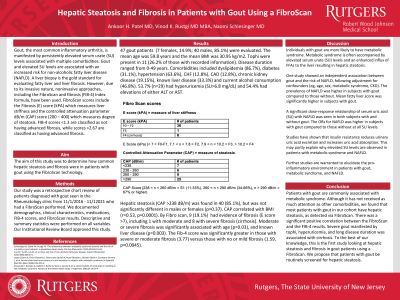Back


Poster Session A - Sunday Afternoon
Category: Liver
A0471 - Hepatic Steatosis and Fibrosis in Patients With Gout Detected by Elastography
Sunday, October 23, 2022
5:00 PM – 7:00 PM ET
Location: Crown Ballroom

Has Audio

Ankoor H. Patel, MD
Rutgers - Robert Wood Johnson Medical School
New Brunswick, NJ
Presenting Author(s)
Ankoor H. Patel, MD1, Vinod Rustgi, MD, MBA1, Anthony E. Yeo, MBBS, PhD, MPH2, Peter Lipsky, MD3, Naomi Schlesinger, MD1
1Rutgers - Robert Wood Johnson Medical School, New Brunswick, NJ; 2Yeo Analytics LLC, Jersey City, NJ; 3AMPEL BioSolutions, Charlottesville, VA
Introduction: Gout is associated with non-alcoholic fatty liver disease (NAFLD), but neither the frequency nor severity of NAFLD in gout is well described. Elastography is a well-established ultrasonic method to evaluate both steatosis and fibrosis in the liver but has not been applied to evaluate gout patients.
Methods: We employed the FibroScan to evaluate patients with advanced gout at one center from 11/1/2016-11/12021. We assessed the Fibrosis score (kPA), which measures liver stiffness (E score), and the controlled attenuation parameter dB/m (CAP) score, which measures steatosis. In addition, we assessed the four-factor fibrosis (FIB-4) Index formula.
Results: 47 gout patients (7 females, 14.9%; 40 males, 85.1%) were evaluated. The mean age was 59.8 years and the mean BMI was 30.95 kg/m2. Tophi were present in 11. Disease duration ranged from 0-49 years. Comorbidities included: dyslipidemia (86.7%), DM (31.1%), HTN (63.6%), CHF (12.8%), CAD (12.8%), CKD (19.15%), known liver disease (33.3%) and current alcohol use (46.8%). 53.7% had hyperuricemia and 54.4% had elevations in ALT/AST.
Hepatic steatosis was found in 40 (85.1%), but was not significantly different in males or females (p=0.37) or those with CHF (p=0.87), CAD (p=0.94), HTN (p=0.17), DM (p=0.68), dyslipidemia (p=0.59) or the presence of known liver diseases (p=0.37). CAP was correlated with BMI (r=0.53, p=0.0001) but not age, serum urate (SU), glucose, triglycerides (TGs), ALT, AST, FIB-4, or Fibrosis scores. By Fibroscan, 9 (19.1%) had evidence of fibrosis (E score >7), including one with moderate and 8 with severe fibrosis (cirrhosis). Moderate or severe fibrosis was significantly associated with age (p=0.03), known liver disease (p=0.003), but not ancestry, gender, BMI, TGs, HDL, glucose, gout duration, CHF, CAD, HTN, dyslipidemia, or DM. SU was comparable in those with or without moderate or severe fibrosis (p=0.24). The Fib-4 score was significantly greater in those with severe or moderate fibrosis (3.77) versus those with no or mild fibrosis (1.59, p=0.0045). There was a significant correlation between the Fibrosis score and FIB-4 score (r2=0.24, p=0.0009), but not between the Fibrosis score and ALT (p=0.44) or AST(p=0.41).
Discussion: Hepatic steatosis and fibrosis are common in patients with gout, but not associated with typical gout co-morbidities. Screening for NAFLD with elastography should establish the actual frequency of NAFLD in gout and provide a means to manage this co-morbidity more effectively.
Disclosures:
Ankoor H. Patel, MD1, Vinod Rustgi, MD, MBA1, Anthony E. Yeo, MBBS, PhD, MPH2, Peter Lipsky, MD3, Naomi Schlesinger, MD1. A0471 - Hepatic Steatosis and Fibrosis in Patients With Gout Detected by Elastography, ACG 2022 Annual Scientific Meeting Abstracts. Charlotte, NC: American College of Gastroenterology.
1Rutgers - Robert Wood Johnson Medical School, New Brunswick, NJ; 2Yeo Analytics LLC, Jersey City, NJ; 3AMPEL BioSolutions, Charlottesville, VA
Introduction: Gout is associated with non-alcoholic fatty liver disease (NAFLD), but neither the frequency nor severity of NAFLD in gout is well described. Elastography is a well-established ultrasonic method to evaluate both steatosis and fibrosis in the liver but has not been applied to evaluate gout patients.
Methods: We employed the FibroScan to evaluate patients with advanced gout at one center from 11/1/2016-11/12021. We assessed the Fibrosis score (kPA), which measures liver stiffness (E score), and the controlled attenuation parameter dB/m (CAP) score, which measures steatosis. In addition, we assessed the four-factor fibrosis (FIB-4) Index formula.
Results: 47 gout patients (7 females, 14.9%; 40 males, 85.1%) were evaluated. The mean age was 59.8 years and the mean BMI was 30.95 kg/m2. Tophi were present in 11. Disease duration ranged from 0-49 years. Comorbidities included: dyslipidemia (86.7%), DM (31.1%), HTN (63.6%), CHF (12.8%), CAD (12.8%), CKD (19.15%), known liver disease (33.3%) and current alcohol use (46.8%). 53.7% had hyperuricemia and 54.4% had elevations in ALT/AST.
Hepatic steatosis was found in 40 (85.1%), but was not significantly different in males or females (p=0.37) or those with CHF (p=0.87), CAD (p=0.94), HTN (p=0.17), DM (p=0.68), dyslipidemia (p=0.59) or the presence of known liver diseases (p=0.37). CAP was correlated with BMI (r=0.53, p=0.0001) but not age, serum urate (SU), glucose, triglycerides (TGs), ALT, AST, FIB-4, or Fibrosis scores. By Fibroscan, 9 (19.1%) had evidence of fibrosis (E score >7), including one with moderate and 8 with severe fibrosis (cirrhosis). Moderate or severe fibrosis was significantly associated with age (p=0.03), known liver disease (p=0.003), but not ancestry, gender, BMI, TGs, HDL, glucose, gout duration, CHF, CAD, HTN, dyslipidemia, or DM. SU was comparable in those with or without moderate or severe fibrosis (p=0.24). The Fib-4 score was significantly greater in those with severe or moderate fibrosis (3.77) versus those with no or mild fibrosis (1.59, p=0.0045). There was a significant correlation between the Fibrosis score and FIB-4 score (r2=0.24, p=0.0009), but not between the Fibrosis score and ALT (p=0.44) or AST(p=0.41).
Discussion: Hepatic steatosis and fibrosis are common in patients with gout, but not associated with typical gout co-morbidities. Screening for NAFLD with elastography should establish the actual frequency of NAFLD in gout and provide a means to manage this co-morbidity more effectively.
Disclosures:
Ankoor Patel indicated no relevant financial relationships.
Vinod Rustgi indicated no relevant financial relationships.
Anthony Yeo indicated no relevant financial relationships.
Peter Lipsky: Ampel Biosolutions LLC – Employee, Owner/Ownership Interest.
Naomi Schlesinger: Horizon Therapeutics – Consultant. LG Chem – Consultant. Novartis – Consultant. Olatec Therapeutics LLC – Consultant, Grant/Research Support. Sobi – Consultant.
Ankoor H. Patel, MD1, Vinod Rustgi, MD, MBA1, Anthony E. Yeo, MBBS, PhD, MPH2, Peter Lipsky, MD3, Naomi Schlesinger, MD1. A0471 - Hepatic Steatosis and Fibrosis in Patients With Gout Detected by Elastography, ACG 2022 Annual Scientific Meeting Abstracts. Charlotte, NC: American College of Gastroenterology.
